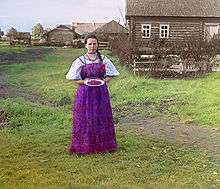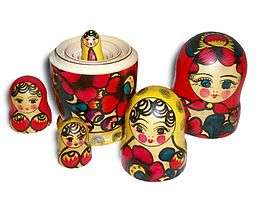Sarafan
A sarafan (Russian: сарафа́н, IPA: [sərɐˈfan], from Persian: سراپا sarāpā, literally "[from] head to feet"),[1] is a long, trapezoidal Russian jumper dress (pinafore dress) worn by girls and women and forming part of Russian traditional folk costume.

Traditional Russian costume consists of straight, flowing lines. Beginning at the turn of the 18th century, the sarafan became the most popular article of peasant women's clothing in the Northern and Central regions of Russia.[2] Sarafans were regularly worn until well into the 20th century, having first been mentioned in chronicles dating back to the year 1376. The origin of the term Sarafan lies in Persia. Old Russia cultivated especially during the era of Grand Principality of Moscow strong ties to Western Asia and countries of the Middle East and served also as an intermediary in the trade between Europe and Asian countries like Persia, as well as Turkey. Sarafan most likely originated from a kaftan-like costume which were worn in Russia by woman and men.[3] Sarafans became mostly popular in the Central and Northern Russian regions. Through trade with Central Europe the quality and colour of clothes became better.
Sarafans had originally a tighter form but became wider through influence of the Russian Orthodox Church.
After the reforms of Peter the Great, which also introduced modern European cultural standards to Russia, only peasants wore the Sarafan, while the upper classes switched to Central European fashion.
In many areas of the former Grand Principality of Moscow and today's Southern Russia also the poneva costume was worn by woman.[4][5] Today the garment is most often seen at performances of Russian folk song, dance and is worn on Russian folk and religious holidays. Designers as well from Russia as from Ukraine are re-imagining the sarafan style with its old national heritage for the 21st century as summertime light dress that can actually be with its modern shape a part of today's woman's wardrobe.[6][7]
Gallery
 Sarafan worn with a Kokoshnik on a Russian folk festival
Sarafan worn with a Kokoshnik on a Russian folk festival A simple black sarafan from Belgorod Oblast
A simple black sarafan from Belgorod Oblast- Ethnic Russian clothes
- Russian women with treshchotka and Russian spoons in their hands. The two women on the right are wearing Sarafans.
The outer layer of a Matryoshka doll is traditionally depicted as wearing a sarafan.
References
- "The Russian Fashion Blog : A Brief History of the Sarafan". www.russianfashionblog.com. Retrieved 2018-08-31.
- "Ensemble | Russian | The Met". The Metropolitan Museum of Art.
- Richard., Hellie (1999). The economy and material culture of Russia, 1600-1725. Chicago: University of Chicago Press. p. 567. ISBN 0226326497. OCLC 39655294.
- "Traditional Dress". The Museum of Russian Art. 2015-10-28. Retrieved 2019-03-03.
- Kirsanova, Raisa. "Russia: History of Dress". LoveToKnow. Retrieved 2019-03-03.
- What Is a Traditional Russian Sarafan? at aerotranslate.com (in Russian)
- "Russian Clothing Tradition. Traditional Russian dress". russianwomen.club. Retrieved 2019-07-24.
External links
| Wikimedia Commons has media related to Sarafan. |

